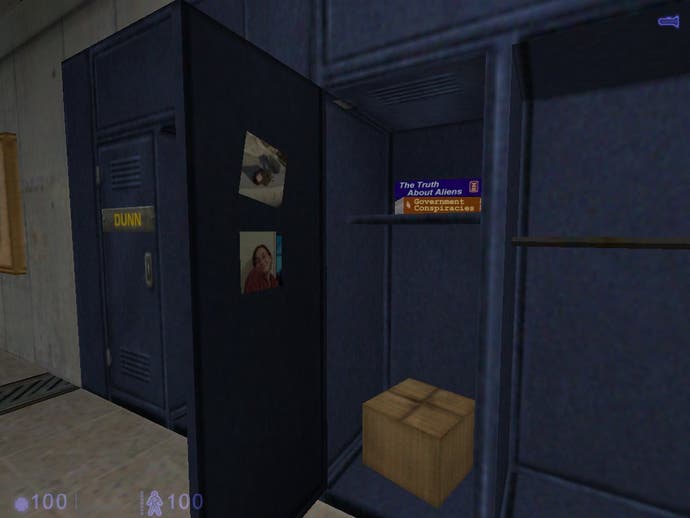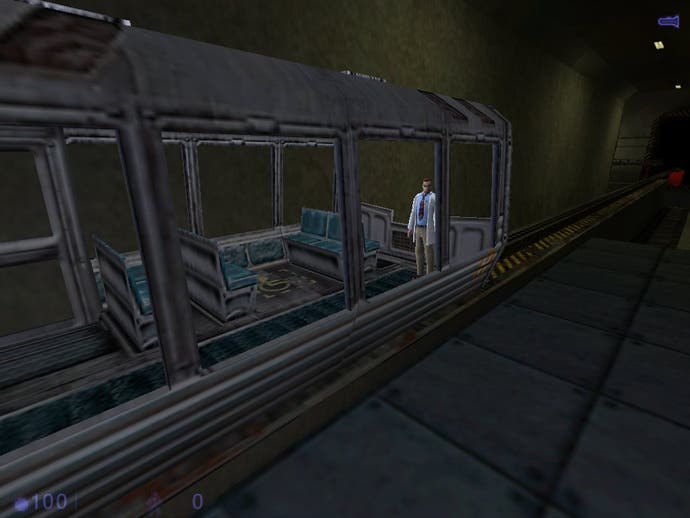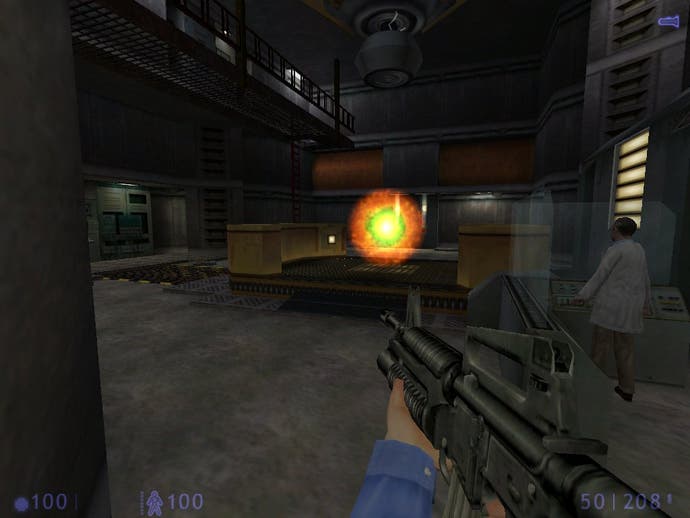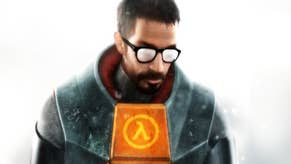Half-Life: Blue Shift
Review - we're heading back to Black Mesa, but it's over in a flash

Welcome to the Black Mesa transit system...
With the sequel nowhere to be seen, it's about time we were due another Half-Life add-on, and luckily for us, Gearbox have teamed up with Valve to produce "Blue Shift", an official stand-alone episode set deep in the bowels of the Black Mesa complex. Blue Shift started life as a value-added episode for the ill-fated Half-Life Dreamcast, and we should have twigged from that that it would be somewhat brief. Unfortunately though, 'brief' doesn't do it justice. Blue Shift is downright tiny, taking a mere three hours to complete for hardened Half-Life players. Newbies may have a bit more trouble, but this reviewer played through it before lunch without losing a single life. That's not the only problem with Blue Shift, either. Although I'm hard pressed to criticize what you get, the complete absence of everything we've learnt from the likes of Counter-Strike and everything since is frankly bizarre. I fear that the task Gearbox's designers were set was "a smaller version of Opposing Force" or thereabouts. After all, this was the padding for the Dreamcast game [Wistful sigh - Ed]. In terms of the storyline… we've done an abandoned scientist and a marine separated from his unit, so now it's time for a security guard. Our latest hero's name is Barney Calhoun, and like Freeman before him Calhoun is dropped in the middle of a cataclysmic crossover between two worlds and forced to fight for his life, not just against alien intruders but the secret government forces sent to depopulate the Black Mesa facility.

Lessons to be learnt
Calhoun's journey starts in a Sector G lift with a couple of stroppy scientists complaining about his workrate. It's during this journey into the depths of Black Mesa that Freeman and his collaborators cause the infamous resonance cascade scenario which plunges the facility into all out conflict. Calhoun faces plenty of interesting puzzles in his attempts to escape, starting with some cunning lift/box placing platform antics and moving on to scripted sequences that depend on destructible scenery and the marine insertion force. In all, it's nothing Opposing Force didn't do, but there are some nice touches here and there, and the interaction with scientists (and the need to keep them alive) is a much higher priority. With Counter-Strike behind us though, you have to wonder why a lot of Blue Shift has come out the way it has. Gearbox clearly learnt a few lessons - for example you get new high definition models - but they haven't realised that the sort of "drop them if you can" real life style of play is what people want. When I picked up the first M16 dropped by a marine and ploughed into his assembled comrades, I immediately jump into CS mode. The marines look like Terrorist guerrillas anyway, so I dropped to my knees and aimed in short bursts at the upper torso of each aggressor, one by one. Bang bang, oh look I'm dead. Why? Because I didn't put 100 bullets in their heads! It doesn't really surprise me that the default loadout is something like 150 rounds of ammunition and how high the M16's rate of fire is - you have to put half a clip at least into each of the marines, and aiming for the weak points doesn't make any difference. The head, the foot, the midriff, you can shoot anywhere, it still takes a while for them to flinch, and they make no attempts to get under cover either. With a bit of tender loving care from the programmers, these marines could have been ducking in and out of cover, poking their heads up over crates and chucking grenades into your cubby hole, or at the very least firing while moving.

Do the timewarp
As it is, it's a step back from the (almost realistic) encounters seen on the Internet's Counter-Strike servers. It's not terribly balanced either - it takes 25 rounds from the M16 to drop a marine, but only one full whack to the upper body from the shotgun. Since this is probably the last chance Gearbox will have to work with these sorts of weapons and troops in the Half-Life storyline, it's a distinct disappointment. The only vague improvement in terms of AI over Half-Life and Opposing Force is the routing of scientists. Since virtually every scientist you catch up with and drag along with you is led by a scripted scenario of some sort, they rarely get stuck, since in effect they're running along an invisible track. That however, is more than can be said for Calhoun, who I managed to get lodged in a wall on three separate occasions. The trick to avoiding this is to follow these simple guidelines: Firstly, don't crouch in lifts. Secondly, don't walk close to the walls in sections which look as though they're barren enough to be "Loading…" corridors. Thirdly, don't for heaven's sake crouch in lifts! Sorry, but the cussing from my window was enough to drive the local children to violence, so it bears repeating. Another thing I found quite annoying in the original Half-Life and now Blue Shift is the way scientists and other security personnel seem delighted to talk over one another. In all three single player Half-Life adventures there have been times when I've thought one chap had stopped speaking, wheeled round and clicked on his mate only to hear them both chirp up simultaneously. It would have been clever (and even amusing) if there was a safe-guard for this with a little "oh, you first", "no, you first", "no, I insist" heave-ho.

Conclusion
Visually it's the same old Half-Life with the addition of smarter high-definition models. The new weapon models are quite nice, although they look rather cartoony, particularly the M16, which doesn't look anywhere near as realistic as the similar M4A1 model seen in pet favourite Counter-Strike. Amazing given the latter was made by a bunch of part-timers working from their bedrooms. Once again Xen lets the game down thanks to its weird visuals and lack of any noticeable gameplay. I thought that the half an hour (1/6 of the game) I spent crawling through little passageways on Xen was easily the most boring part of the game, and I suppose unsurprisingly Blue Shift continues the downward spiral of poor end sequences. This doesn't even really qualify. It's a "right then" as opposed to Half-Life's "cor…" Now, if you've done your homework, you will at this point be whinging, "for goodness sake man! All this and it only costs a tenner!" Well damn me and my high standards. Valve set them with the original Half-Life, and since then Gooseman and co. have set them higher with Counter-Strike. A tenner it may cost, but it's still only three hours of entertainment, and utterly linear with zero replay value for the average gamer. The inclusion of high-definition models and other bits and bobs on the CD are useful but nothing particularly special. If you have a yearning for more Half-Life, Blue Shift will definitely satisfy you for a little while, but this is probably the original Half-Life's swansong, and it would have been nice to see them take things a step beyond the cut and paste action format.
-
Half-Life: Blue Shift Screenshots
Half-Life: Opposing Force Review









